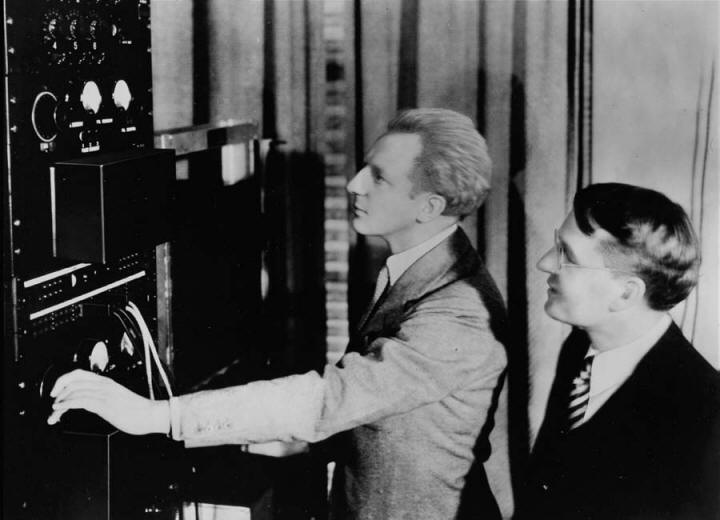During the 2016 Grammy Awards held on Monday, 15 February 2016, at the Staples Center in Los Angeles, California, one of Provo, Utah’s very own was awarded a Grammy.
Dr. Harvey Fletcher, known as the “father of stereophonic sound” was finally nationally recognized almost 35 years after his death for his groundbreaking research and numerous inventions related to stereophonic sound, which set the path and helped to create everything we have in the music industry today. Fletcher was awarded a Technical Grammy Award along with Turntable Manufacturer EMT.
A Grammy is an amazing honor, one which every musician, actor, scientist, writer, etc. dreams of receiving. It is “an accolade by the National Academy of Recording Arts and Sciences of the United States to recognize outstanding achievement in mainly English-language music industry.” Who is better fit to receive this award than the man who literally made music possible?
 Harvey Fletcher was born in Provo, Utah in 1884. In 1907 he graduated from Brigham Young University. Although he was very successful in his educational journey, it was not easy. He worked his way through Brigham Young University as a grocery deliveryman, making very little money as he pursued his dreams. Immediately after receiving his degree at BYU he went on to pursue a Ph.D. in physics at the University of Chicago, graduated from there in 1911, and returned to BYU to head up its physics department.
Harvey Fletcher was born in Provo, Utah in 1884. In 1907 he graduated from Brigham Young University. Although he was very successful in his educational journey, it was not easy. He worked his way through Brigham Young University as a grocery deliveryman, making very little money as he pursued his dreams. Immediately after receiving his degree at BYU he went on to pursue a Ph.D. in physics at the University of Chicago, graduated from there in 1911, and returned to BYU to head up its physics department.
Five years later Fletcher accepted a job offer from the Western Electric Company, which later became Bell Telephone Laboratories. His contributions there helped create the Bell telephone network, which is now the largest in the world!!
Working with Bell Telephone Laboratories was only one of his many jobs, creations, and contributions to society and the music and sound industry, which we are privileged to have today.
Harvey Fletcher was also credited with the invention of the first electronic hearing aid and artificial larynx. The artificial larynx is what helps people learn and regain their speech after Laryngeal surgery. As far as the hearing aid goes, industrialist Alfred DuPont requested that Fletcher help find a way to improve hearing. The way it was accomplished was through using vacuum tubes, which contained two microphones that were connected to telephone receivers in a headband. With his success, Alfred DuPont’s hearing was improved. Harvey Fletcher later went on to make one for a fellow inventor, now widely admired in society today, Thomas Edison.
Starting around the 1930’s is when stereophonic sound recording and experiments began taking place. In March of 1932, Fletcher, along with Stokowski and the Philadelphia Orchestra, participated in a test recording. This consisted of the group using two microphones that were linked to two styli cutting two separate grooves on the same wax disc. The experiment test was successful, being known as “Prometheus: Poem of Fire,” which is the earliest known surviving intentional stereo recording.
Five years later after perfecting the system, it was expanded onto film recordings, one such being Walt Disney’s film “Fantasia.”
His work with spatial effects of sound produced amazing and dramatic experiences for audiences. On 24 January 1934, following one of his first demonstrations of three-dimensional sound, the New York Times reported that the audience present was “mystified” and “often terrified.” The article continued saying, “Had it not been for the knowledge that they were witnessing a practical scientific demonstration, the audience might have believed they were attending a spiritualist séance. Airplanes flew from the stage and circled over the heads of the audience with so much realism that all present craned their necks in fright.” How I would have loved to be present and experience this break through of a demonstration.
 One more touching story is about how at a meeting of the board of managers of the American Federation of Organizations of the Hard of Hearing, Fletcher equipped the attendants with amplifiers that allowed them to hear a public speech for the first time. It is written that tears swelled in their eyes as they first experienced the miraculous gift and power of sound.
One more touching story is about how at a meeting of the board of managers of the American Federation of Organizations of the Hard of Hearing, Fletcher equipped the attendants with amplifiers that allowed them to hear a public speech for the first time. It is written that tears swelled in their eyes as they first experienced the miraculous gift and power of sound.
Although Harvey Fletcher was very successful and loved by many, in the end he returned to his home town and the place that changed his life, Brigham Young University, and there served as the founding Dean of the BYU College of Engineering. An engineering building on campus now carries his name.
Fletcher’s son, Robert Fletcher, said of his father, “He was certainly my hero, but not so much in physics capability, but just as a person.”
Harvey Fletcher lived a long, happy, and successful life, truly changing the world with his dreams and creations coming to life. Fletcher died in Provo in 1981 at the age of 96, only a few weeks before his 97th birthday. Fletcher’s life long work ended with him publishing over 60 major scientific works, and holding more than 40 patents relating to acoustical devices. Harvey Fletcher was truly a cutting-edge and revolutionary nuclear physicist and creator.
Glen Anderson created a video called “Harvey Fletcher Story” which was shown at the BYU Spectacular 2010 performance on 7-8 October 2010.


